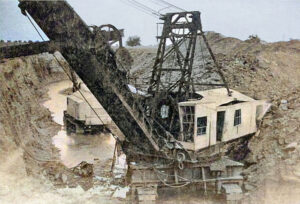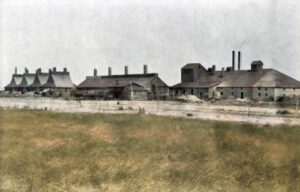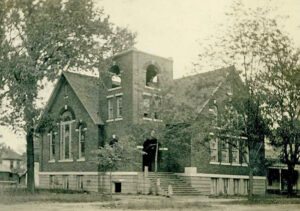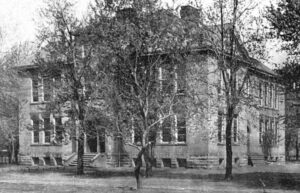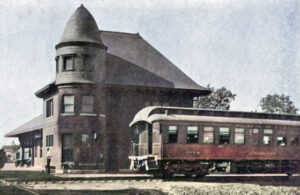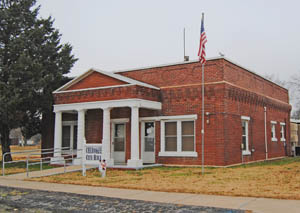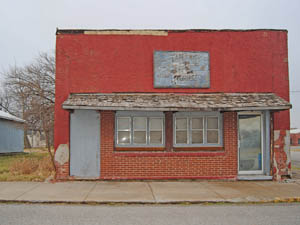Cherokee, Kansas, is a small town in Sheridan Township in southern Crawford County. As of the 2020 census, the city’s population was 590, and its total area was 0.71 square miles, all land.
The land that forms the townsite was originally the property of John J. Hoke and John G. Knox. The townsite was donated to the Missouri River, Fort Scott & Gulf Railroad Company, which extended its line from Fort Scott to Baxter Springs, Kansas. The railroad platted and laid out the town in April 1870 and began selling lots. It was named Cherokee because it was thought to be located within the boundaries of Cherokee County. However, it is actually located in south Crawford County on the county line.
The 300 square miles of coalfields surrounding Cherokee made it a popular destination for workers. The attraction of a naturally fertile and promising country and the extravagant advertisements of the railroad company induced a rapid influx of settlers.
The first building on the townsite was a small box house erected by William R. Sharp. This house was used as a storeroom, where a stock of groceries, feed, and bad whisky was kept. Shortly after this, the railroad section house was built. Tom McGraw kept the first saloon.
A post office was established on August 12, 1870, with William R. Sharp serving as the first postmaster.
Captain Jamison established the first school in this vicinity in 1870. During the summer of that year, Jamison built a house about a mile south of the town and furnished the teacher and his daughter, M.H. Alberty, and books to those unable to procure them free of charge. This was a “free school” since Jamison furnished its support and extended its accommodations to all the children of the neighborhood without charge. The average attendance was about 13.
That year, the first religious organization was established — the Union Sunday School. Thomas Graham was the first Superintendent, and the exercises were conducted in a hay shed on Mr. Heiner’s farm. During the summer, they were held in Jamison’s schoolhouse.
Miss Sarah Jamison taught the first school in town in 1871, and it was kept in the old section house. The attendance was very small, with just seven students, and the school was short-lived.
The Cherokee Flouring Mill was built in 1871 by Alberty & Vaughan. The cost of the building and machinery was about $20,000. It contained three runs of stones and a steam corn-sheller. The mill was held under lease by the firm of Morley & Moore, which operated it.
A school building was erected in 1872. The house’s plan was only one story, but later, a second story was built.
The Methodist Episcopal Church was organized in 1872 by Reverend B. Combs, with a membership of six. It held services in the school building until the erection of a church house in 1874. It is a one-story frame building measuring 36×68 feet, costing $2,700.
The United Brethren Congregation was organized in 1875, and the church building was finished in 1879. At present, the body is without a regular pastor.
The Anchor Flouring Mill, owned by S.E. Leigh, was built in 1873. It contained two run of buhrs and was operated in connection with a flourishing business.
The City of Cherokee, Kansas, was incorporated as a third-class city on March 2, 1874.
The Cherokee Machine Shops were established in 1874 by Frank Webster. They began as a blacksmith shop, and gradually, machinery was added. The shop contained a lathe, polishing and grinding machinery, drill press, and a complete set of pipe tools. A ten-horsepower engine ran it.
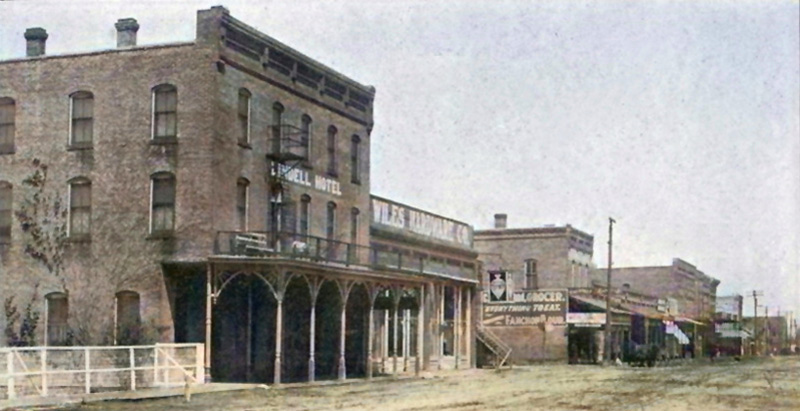
Main Street in early-day Cherokee, Kansas.
The Cherokee Pharos was moved from Girard to Cherokee in May 1874 by W.K. Goode. It was continued at this place only until the fall of the same year and, in September, was returned to Girard.
The Cherokee Index was started by Mrs. Mary A. Spring on June 3, 1875. In July of that year, H.C. Brandon became editor and was succeeded in a few weeks by P.J. Coston. After editing the paper until November 5, 1875, Coston gave up the editorship. On December 17, Mrs. Spring sold out to G.W.B. Hoffman and John T. Metcalf. In April 1875, Metcalf sold his interest to Hoffman, who converted the paper, previously published as an Independent sheet, into a Democratic organ.
The Young Cherokee newspaper, a small amateur concern, was established by H.H. Webb and H.L. St. Clair. The first edition circulated on May 13, 1876. St. Clair quit the next month, and in the following month, Webb largely increased the size of the sheet. In the spring of 1877, during the great lead excitement at Short Creek, the paper was taken to that place, the first issue being made on May 26, 1877. The paper afterward became the Mining Echo.
The Presbyterian Church was organized in 1876 and built in 1880. The building was finished with a steeple, which was blown off by a wind storm on July 3, 1882, causing considerable damage to the entire structure. The colored people have an organization and hold meetings in the United Brethren church building.
The Christian Church was organized on March 24, 1877, by Reverend E. R. Childers of Fulton, Mo. The church began with 21 members. The organization and early services were conducted in the Methodist Church, but meetings were later held in the Presbyterian Church.
The Cherokee Banner was started in the fall of 1877, with the first issue appearing on October 6. H.H. Webb was also the founder of this paper. It was purchased by S. Smith on July 12, 1878, and continued its publications. The paper was finally suspended.
On March 16, 1878, John T. Metcalf bought back his interest in the Cherokee Index and re-formed the partnership. On September 21, 1878, the newspaper was moved to Columbus, Cherokee County.
The Temperance Rural was established on July 4, 1878, by J.F. St. Clair and J.S. Moore. It was devoted to the advocacy of temperance but was subsequently suspended.
The Cherokee Sentinel was established in April 1879 by Charles M. Lucas. It began as a four-column paper but was enlarged to an eight-column one at the end of the first year. The paper enjoyed increasing patronage and prosperity since its beginning and became one of the city’s firmly established institutions.
By 1880, Cherokee’s population was 556.
The banking firm of G.W. Pye & Co. began in October 1881, during which time it conducted a prosperous business. G.W. Pye was the head of the concern, and J.C. Smith was the Cashier.
A new, sizeable two-story brick schoolhouse was built in the latter part of 1882. It was a structure of elegant design and finish, costing about $8,000. The school, which was comprised of four departments, enrolled 324 students.
Edward and Robertson established a broom factory in 1882. They run two machines and produce considerable, excellent-quality work.
In 1910, Cherokee was at the junction of the St. Louis and San Francisco and the Missouri Pacific Railroads. At that time, it had two national banks, flour mills, grain elevators, an ice plant, a broom factory, a telephone exchange, good hotels, churches of the principal denominations, a graded school system, telegraph and express offices, a number of first class mercantile establishments, and a weekly newspaper called the Sentinel. Its post office issued international money orders, and two rural delivery routes supplied a large district with daily mail. The town was located in one of the finest agricultural regions in that section of the state, and it was the shipping point for large quantities of grain and livestock. Fine-quality coal was extensively mined in the area. The city’s population peaked in 1910 at 1,452.
Today, Cherokee is served by Southeast USD 247, which is headquartered in Cherokee. The district includes the communities of Cherokee, McCune, Sherman, Weir, West Mineral, and nearby rural areas. Crawford and Cherokee counties include portions of the district. The Southeast High School mascot is the Lancers.
The community has three churches: the United Methodist Church, First Baptist Church, and the Cherokee Holiness Church.
Cherokee has an annual Homecoming/Fall Festival in September, a Friday Night Car Show and Car Cruise during the summer months, a City-Wide Clean-up and Garage Sale in April and October, a Free Community Thanksgiving dinner in November, and a Christmas Party for kids in December.
Cherokee is just north of the Cherokee-Crawford County Line at the intersection of Highway 7 and Highway 400. It is 12 miles south of Girard, the county seat.
©Kathy Alexander/Legends of Kansas, updated April 2025.
Also See:
Sources:
Blackmar, Frank W.; Kansas: A Cyclopedia of State History, Vol I; Standard Publishing Company, Chicago, IL 1912.
City of Cherokee
Cutler, William G; History of Kansas; A. T. Andreas, Chicago, IL, 1883.
Wikipedia


